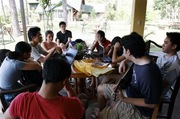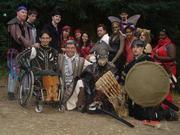Role Playing for Adolescent Students
Role Playing for Adolescent Students
Professional Advocacy
Examples of Role Play in the Classroom
Benefits
Role Playing Games
Related Links
References
Photos
More Than Just A Game
When the phrase “Role-playing” is used, the average person might immediately conjure up images of dragons or vampires, of teenagers with glasses huddled in their parents’ basements rolling dice around a table, or of overweight young men sitting at computers for hours on end wrapped up in a virtual fantasy world. Often overlooked are the positive effects Role-playing can have on adolescent development.
Rich and Storied History
The concept of stepping into another “role” to portray something in an artificial environment is nothing new; “war games” are thousands of years old, and children pretending to be Cowboys, Indians, Knights, Astronauts, etc. have been doing so for as long as there have been children.
Role-playing is an under-used but extremely useful tool for educators of adolescent students. It can be used in almost any type of classroom at almost any grade level. Role-playing in the classroom is a creative activity that gives students the chance to become personally invested in the lesson, thus more likely to retain detailed knowledge than a more traditional lecture. Outside of the classroom, Role-playing encourages teamwork, reading, positive social interaction, and creative expression. It is a safe, fun activity that can stimulate the imagination of an adolescent, and also an activity that parents and educators alike can participate in.[1]
[1] Scott Kurtz, “5 Reasons Your Kids Should Play Dungeons and Dragons,” Pvponline, 2005, [Internet]; available from http://www.pvponline.com/rants_dd.php3 (accessed 20 June 2007).

